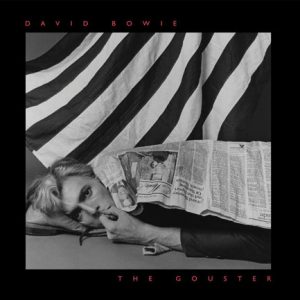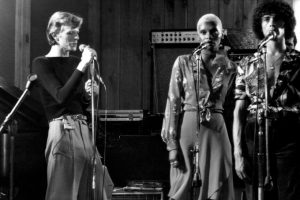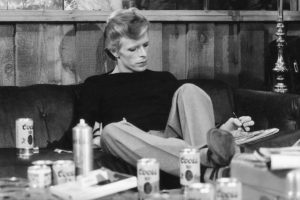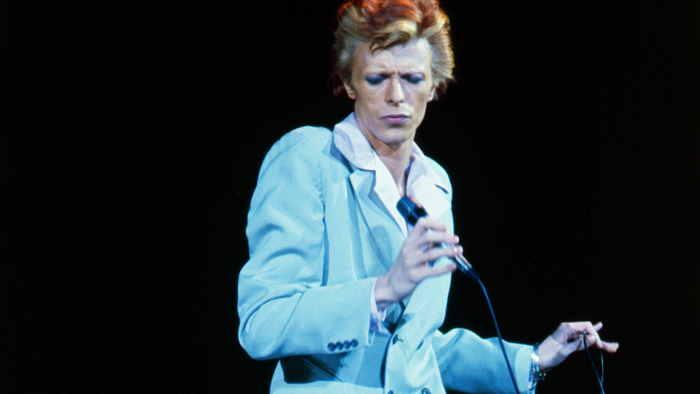How it got made—and why it was shelved—from those that were there.
You know, he called that record plastic soul, but no one will dare call it plastic soul now,” Carlos Alomar, David Bowie’s longtime guitarist, says of the newly unearthed album The Gouster, out today as part of the spectacular Who Can I Be Now? (1974-1976) box set. “Why? Because it came from the soul of David Bowie. You can’t call it plastic soul. It’s the perfect soul album.”
The Gouster was born in the summer of 1974, at recording sessions at Philadelphia’s Sigma Sound during a break in the tour for Bowie’s Diamond Dogs album. The sessions would eventually stretch into 1975, and would include Bowie’s collaboration with John Lennon on his first number-one song “Fame,” and would ultimately be released as Bowie’s breakout U.S. album, Young Americans. But while Diamond Dogs featured Bowie and a cast of English musicians putting a stake through the heart of his Ziggy Stardust character and toying with soul music—and Young Americans would boast a rockier, edgier soul-tinged sound that would entrance the massive FM-radio market—The Gouster was a pure soul record.
“It was a pretty striking change from just a few months earlier,” says the photographer Terry O’Neill, whose images—from his forthcoming book Bowie by O’Neill—adorn this piece. “That’s what I loved about him. He kept changing his image. He wasn’t the same singer the next time you saw him.”

Versions of each of the seven songs on the album were released in one form or another over the years, but listing to The Gouster with its original, intended track order offers a tantalizing glimpse into where David Bowie was as an artist during this hugely fertile period of his career. It also represents an undeniable missing link between 1973’s Diamond Dogs and 1975’s Young Americans.
“When I first met him, basically all we talked about was about soul music and rhythm and blues,” Alomar says of his first inkling that there was more to the pasty-faced glam rocker he’d connected with on a recording session for British singer Lulu. “I realized that his interest in soul music was from the very, very beginning of his life, and that he was very well-educated.”
There were people who had doubts, but because I knew David very well, I knew he could do anything.
Keyboardist Mike Garson, who began playing with Bowie during the final days of Ziggy Stardust and the Spiders From Mars, echoes that sentiment. “I took the gig because I knew the guy was great, but you don’t always know just how great,” Garson recalls. He knew of Bowie’s interest in soul music, and of his aspirations to make his own mark within the genre. “I knew about the project, because I would drive around with him in the limo while we were on the Diamond Dogs tour. There were people who had doubts, but because I knew David very well, I knew he could do anything.”
“At the end of the tour, he said, ‘Listen, I’m going to go to Philly and record. Do you want to come along?'” saxophonist David Sanborn says. The destination served as more than just a city with a recording studio. “I knew he was in love with American soul music, [especially] ‘TSOP (The Sound of Philadelphia)’ and the Mother, Father, Sister, Brother records,” Sanborn explains. “They’d had a real profound effect on him. That led him to want to go to Philly, to go where the stuff actually happened and absorb some of the vibe.”
“He wanted the people who were the session players from ‘TSOP,’ but they didn’t want to do it,” recalls Robin Clark, Alomar’s wife and one of the backing vocalists on The Gouster. “But what David realized was that he could get the sound he was after by putting the right musicians and the right singers in a room.”
Piecing together the band was a major feat. “We’re talking about the cream of the crop and then how the cream of the crop blended,” Garson says of the band, which along with Sanborn, Alomar, and Garson included drummer Andy Newmark, bassist Willie Weeks, and percussionist Larry Washington. “These guys were seasoned session musicians,” Alomar says. “All they do, all day long, is lay down grooves. They’re not impatient, they just wait, and they listen to each other, and they never ever, ever overplay.”
Terry O’Neill photographed the sessions, and was amazed at what he witnessed. “Even though he was making this huge left turn he seemed supremely confident,” O’Neill recalls. “He was sort of like Frank Sinatra in the studio. Whatever he did or sang, everyone followed. It all revolved around him. He had that authority.”
The musicians, however, recall Bowie as the consummate collaborator. “The brilliance of Bowie was that he gave us the framework and then it was the unseen, unfelt hand of guidance from him,” says Sanborn. “He was very clearly in charge, but was not ‘in charge,’ if you know what I mean.” Garson uses a Hollywood metaphor to describe Bowie’s method of overseeing the musicians. “I always think of David as the ultimate casting director,” he says, summing it all up. “When he chose people, he let them do their thing.”
I always think of David as the ultimate casting director. When he chose people, he let them do their thing.
While the interplay between Garson, Alomar, and the rhythm section throughout The Gouster is astonishingly tight and deeply soulful, it’s Sanborn’s saxophone that truly steals the show. “I think David and I bonded because he was a saxophone player, too,” says Sanborn. “The way he presented it to me at the outset of the sessions was, ‘There’s not going to be any lead guitar on this record. There’s going to be rhythm guitar and bass and drums and piano. You’re going to be the lead guitar.’ I didn’t really know how that was going to work, but I put myself in that mindset.”
While the interplay between Garson, Alomar, and the rhythm section throughout The Gouster is astonishingly tight and deeply soulful, it’s Sanborn’s saxophone that truly steals the show. “I think David and I bonded because he was a saxophone player, too,” says Sanborn. “The way he presented it to me at the outset of the sessions was, ‘There’s not going to be any lead guitar on this record. There’s going to be rhythm guitar and bass and drums and piano. You’re going to be the lead guitar.’ I didn’t really know how that was going to work, but I put myself in that mindset.”
Accordingly, Sanborn remembers the sessions as a seat-of-the-pants experience. “I really didn’t have any parts,” he says. “But I had been on the road with him, so we had a kind of dialogue. That was one of the great, great things about working with him: He was so responsive to input.”
The backing vocals–featuring Clark, tour singers Ava Cherry and Geoff MacCormack, and future star Luther Vandross–are another key ingredient of The Gouster’s soulful magic. Remarkably, the unforgettable backing vocals happened almost by accident. Clark and Vandross had accompanied Alomar to Philadelphia to check out the sessions, but they couldn’t just sit there idly by, either. When the pair, seated in the control room of Sigma Sound during a playback, chimed in naturally with the now familiar backing vocal response in “Young Americans,” Bowie immediately asked the pair to put their idea down on tape.

“David got that we worked well together,” Clark says. “But he also knew that he’d found something he didn’t even know he was looking for the minute he heard it. Then it was, ‘Now let’s do the rest of the album.'”
Vandross, who became a highly sought-after jingle singer and arranger, and later a superstar in his own right, became Bowie’s secret weapon. “Luther came up with most of the background vocal parts,” says Sanborn. “He and David were very much collaborators.”
Yet another piece of that puzzle was the return of Tony Visconti to the producer’s chair, after a four-year absence, during which time Bowie became an international superstar. Visconti reconnected with Bowie during the mixing of Diamond Dogs, and then was called in to work on 1974s David Live album. “It was never clear to me who was actually in charge,” says Sanborn. “It was very much, in retrospect, a collaboration between David and Tony. But the labels of producer, artist, engineer, certainly in that situation, were meaningless because there was a remarkable lack of ego present.”
At the end of the week of round-the-clock sessions at Sigma Sound, Bowie enlisted a focus group of sorts to test out the fruits of his latest adventure.
“We had been hanging out around the studio for roughly two weeks,” remembers Patti Brett, who was one of a group of fans who Bowie’s entourage dubbed the Sigma Kids. “One night when he arrived at the studio he said that if we were there when he came out he’d have a surprise for us.” The surprise was an in-studio listening session of The Gouster. “He told us it was unlike anything else he’d done and that he really wanted to get some feedback,” she continues. “They played it for us, and you could tell he was nervous. But at the end someone shouted, ‘Play it again!’ And he got this huge grin on his face and said, ‘Really?’ And everyone screamed, ‘Yes!!’ And he played it again, and that started the party.”
Shortly after that evening, Bowie and his band left for the second leg of his Diamond Dogs tour—now dubbed Soul Dogs—and Visconti headed to London to mix The Gouster. But Bowie wasn’t finished.

“After Diamond Dogs, something like The Gouster would have been completely unexpected,” says Clark. “I think David was caught between a rock and a hard place. He wanted to do what he wanted to do, but at the same time he had so make certain choices that would fulfill the expectations of his audience and his record company.”
“With the passage of time, I get why he went with Young Americans,” says Sanborn. “It was very accessible, and it was a gateway drug into the rest of the music. A person listening to pop radio needed ‘Young Americans’ and ‘Fame’ to be introduced to what he was trying to do.”
“It takes absolute confidence in your ability and in knowing where you’re going and what your aim is to be able to make a real, true soul record like that,” Clark says, summing up her memories of Bowie from the time. “David wasn’t trying to imitate any of the singers of the time. He remained David, and that’s what made it so hip. He would laugh that off and say that this was his white-boy version of soul, but that’s not it at all. He found inside of himself that soul singer that he always wanted to be.”
“He was a genius on so many levels: Media manipulation, image, propaganda, everything,” Sanborn says of Bowie, whom he last saw in 2002. “He had totality. But closer to home, for me, he was just one of the guys, slugging away, trying to make this shit happen, like the rest of us. That this album sat on a shelf for all these years is a testament to that.”
Stream The Gouster, from the newly released box set Who Can I Be Now? (1974-1976), in the Spotify playlist below


5
5